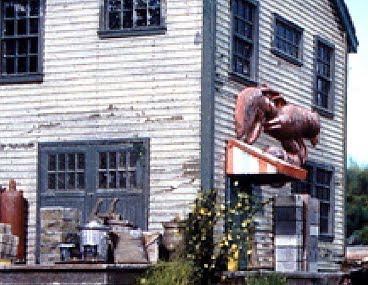

Here's a close-up showing peeling paint on an HO waterfront structure. Sorry about the photo quality.
I use art masking fluid to mask the wall where the peeling paint will be. Art masking fluid is like rubber cement only thinner. It's mostly sold in art stores, but I've seen it in craft stores also. Art masking fluid is used by water color painters to mask areas they whant to remain white. You'll also need a soft rubber erasure like the one in the photo.
Here's what to do:
• On a wood structure paint the raw wood a weathered wood color. I like a thinned gray color.
• Where you want the peeling paint apply art masking fluid with a toothpick - a little is better than a lot.
• Allow the art masking fluid to dry.
• Then paint the whole structure another color - white, barn red, gray, light green, whatever you like.
• Allow the paint to dry for several days
• Then with the soft rubber art eraser gently rub it over the structure surface. The eraser will lift the paint and the art masking fluid under it to reveal the weathered wood.








